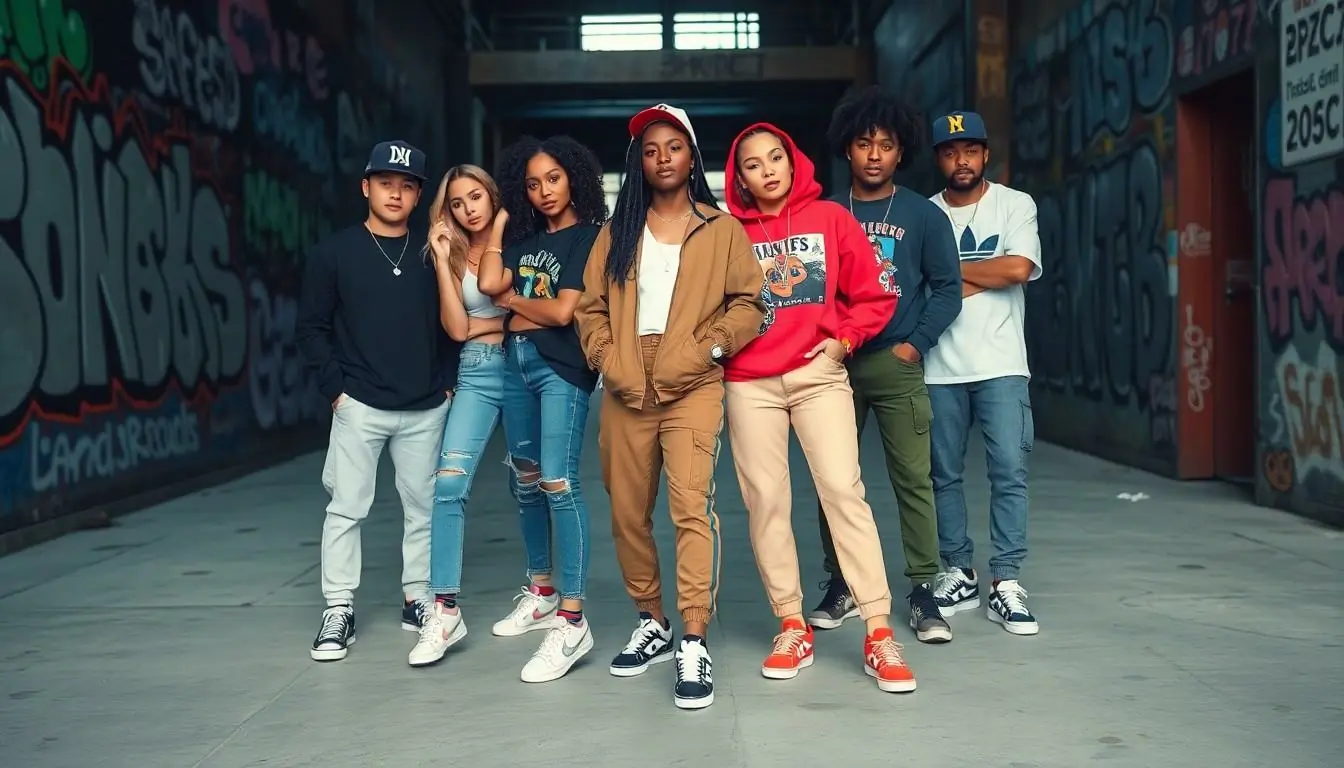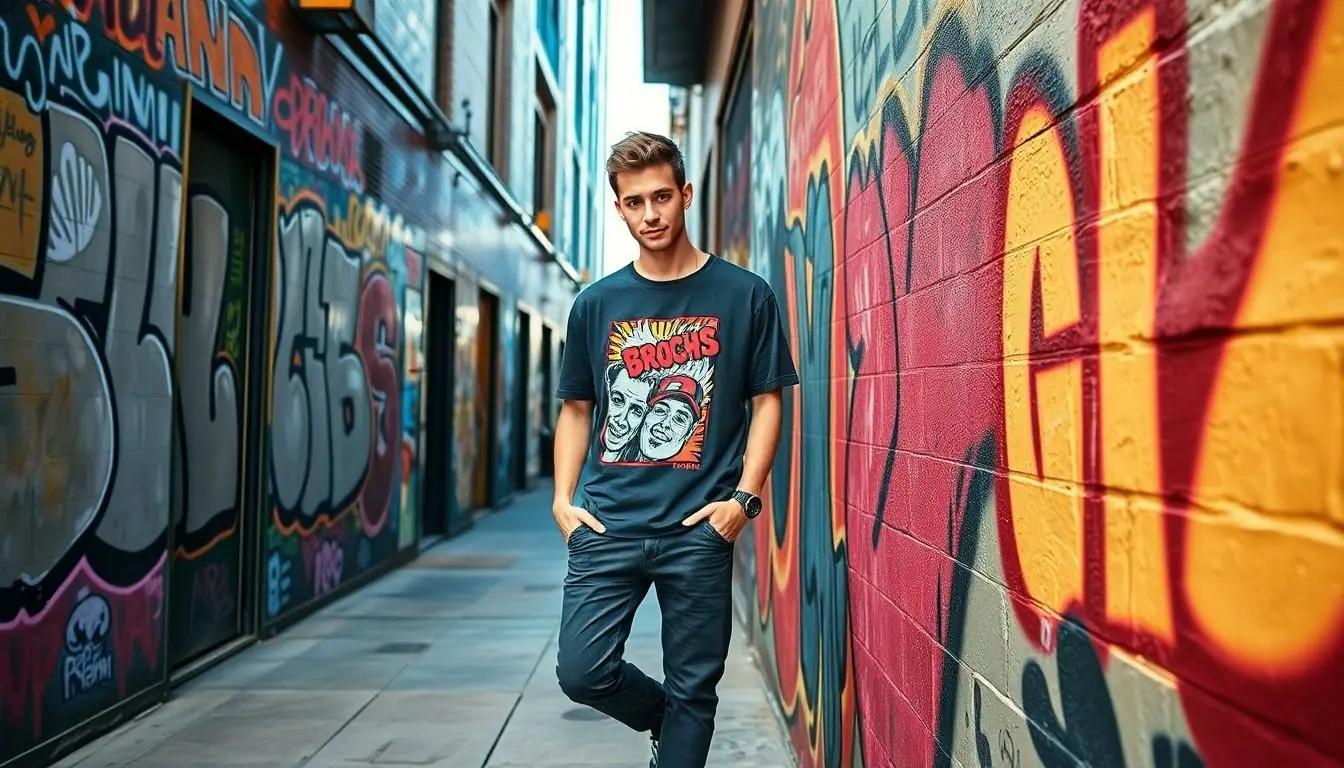Table of Contents
ToggleStreetwear isn’t just a fashion trend; it’s a cultural phenomenon that’s taken the world by storm. Imagine a style that effortlessly blends comfort and creativity, where oversized hoodies meet high-end sneakers. It’s the kind of look that says, “I woke up like this,” while secretly being curated with precision.
But what exactly is streetwear? It’s more than just clothes; it’s a lifestyle, a movement rooted in urban culture and influenced by music, art, and social movements. Whether you’re a sneakerhead or just someone who appreciates a good graphic tee, streetwear has something for everyone. So buckle up as we dive into the vibrant world of streetwear, where self-expression reigns supreme and every outfit tells a story.
Understanding Streetwear Definition
Streetwear represents a fusion of casual fashion and urban culture. It’s a dynamic movement, rooted in self-expression and influenced by various artistic forms.
Origins of Streetwear
Streetwear emerged in the late 1970s and early 1980s, inspired by skateboarding, hip-hop, and punk movements. Pioneering designers like Shawn Stussy and later brands such as Supreme played crucial roles in shaping its identity. Elevated streetwear culture witnessed a surge in popularity during the 1990s, particularly as global youth embraced its distinct style. It reflects societal changes and responds to real-world issues, allowing wearers to connect with their communities.
Key Characteristics of Streetwear
Streetwear is known for its casual, laid-back aesthetic. Graphic tees featuring bold graphics form a staple within the wardrobe. Sneakers often take center stage, offering both comfort and statement-making appeal. Limited edition items and collaborations create an allure around exclusivity. Quality fabrics and innovative designs contribute to durability and style. Lastly, streetwear promotes individuality, encouraging wearers to mix and match pieces for a personal flair.
Influential Brands in Streetwear

Streetwear features several influential brands that define and drive its trends.
Established Streetwear Labels
Supreme stands out as a leading brand, known for its iconic box logo and limited-release collaborations. Nike, through its partnership with various streetwear designers, provides essential footwear for urban fashion enthusiasts. A Bathing Ape, or BAPE, is recognized for its distinct camouflage patterns and ape logo, solidifying its position in the market. Stüssy maintains a legacy since the 1980s, blending surf culture with street aesthetics. Off-White, led by Virgil Abloh, has redefined luxury streetwear with its bold graphics and deconstructed designs. Each established label contributes unique characteristics that influence the streetwear landscape.
Emerging Brands to Watch
A plethora of emerging brands captures attention in the streetwear scene. Fear of God combines high fashion with street sensibilities, focusing on quality craftsmanship. PLEASURES merges various cultural references, bringing a punk-inspired aesthetic to modern trends. 101 Apparel emphasizes sustainable materials while promoting individuality, appealing to eco-conscious consumers. The Hundreds combines streetwear with skate culture, fostering a community-centric approach. Kith stands out through its vibrant designs and partnerships with iconic brands. Each rising star brings fresh perspectives, indicating the ongoing evolution of streetwear.
Streetwear Culture and Community
Streetwear represents more than just a fashion trend; it embodies a vibrant community shaped by creativity and social interaction. The culture thrives on a sense of belonging and collective identity among its followers.
Role of Social Media in Streetwear
Social media plays a pivotal role in defining streetwear culture. Platforms like Instagram and TikTok allow users to showcase their unique styles and connect with like-minded individuals. Pictures of limited-edition releases and influencer outfits often circulate, driving demand and excitement. Online discussions and hashtags also foster community engagement, allowing fans to share insights and inspirations. Brands frequently collaborate with popular social media figures, amplifying their reach and appeal. This interconnectedness keeps streetwear trends dynamic and relevant, showcasing real-time feedback from enthusiasts.
Streetwear and Music Influences
Music heavily influences streetwear’s aesthetic and identity. Genres like hip-hop, punk, and skate culture intertwine with fashion trends, fueling creativity. Artists often collaborate with streetwear brands, merging musical artistry with clothing design. Iconic moments, such as collaborations between musicians and fashion labels, elevate streetwear’s status. The rise of music festivals sees attendees sporting signature streetwear styles, creating a unique blend of self-expression and culture. Change in music trends similarly reflects in clothing choices, illustrating the symbiotic relationship between sound and style.
The Evolution of Streetwear
Streetwear has undergone significant changes since its inception, reflecting cultural shifts and evolving trends.
Trends Over the Years
Streetwear trends continually adapt, influenced by various social movements and cultural events. The 1980s saw an emergence of brightly colored graphic tees and oversized silhouettes, emphasizing individuality. The 1990s introduced the rise of logo-centric designs, with brands like Supreme and Stüssy becoming mainstream staples. In the 2000s, collaborations between high fashion and street brands gained traction, blurring the lines of traditional fashion categories. Recent years showcase a growing emphasis on sustainability, with many brands incorporating eco-friendly materials. Consumers increasingly value authenticity, pushing for limited-edition releases that foster connection and exclusivity.
Future Prospects of Streetwear
Streetwear is poised for continued evolution, embracing technological advancements and societal shifts. The integration of augmented reality and virtual fashion presents new opportunities for expression and engagement. It may also see an increased focus on inclusivity, as diverse voices shape future designs. Sustainability remains a priority, with rising consumer demand for eco-conscious practices driving brands to innovate. The synergy between streetwear and digital culture points towards a future where online presence and physical fashion coexist harmoniously. As the community grows, collaborations with diverse artists and influencers will strengthen the cultural significance of streetwear, further embedding it in contemporary society.
Streetwear stands as a powerful expression of individuality and cultural identity. It transcends mere fashion by weaving together elements of art music and community. As it continues to evolve streetwear reflects changing societal values while embracing innovation and sustainability. The influence of social media and collaborations with artists keeps it relevant and dynamic. This vibrant culture not only shapes trends but also fosters a sense of belonging among its followers. With its roots firmly planted in urban life streetwear will undoubtedly continue to inspire and connect people across the globe.






